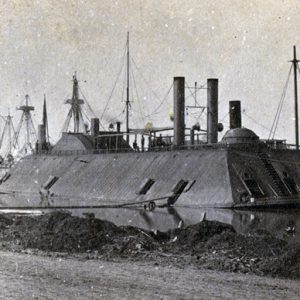calsfoundation@cals.org
USS New Era
The sternwheel steamer New Era saw extensive service with the Union’s Western Gunboat Fleet during the Civil War, including operations on the White and Mississippi rivers during the ongoing battle for control of significant interior rivers in the Trans-Mississippi Department. At least three wartime vessels of this name participated in Union naval operations at various times. Consequently, details of its service are somewhat muddled.
Built in Wellsville, Ohio, in 1862, the New Era served on the Ohio River until it was purchased for service on the western rivers. The 137-foot vessel displaced 157 tons and drew four to six feet of water. Its armaments included six twenty-four-pound howitzers. Purchased by the U.S. Navy at Cincinnati, Ohio, on October 27, 1862, the vessel began its federal service on the Tennessee River with Acting Master Frank W. F. Flanner in command.
By December 24, 1862, it served in support of the supply garrison at Columbus, Kentucky, which supported the Union’s army and naval operations at Vicksburg, Mississippi. Once the threat to the garrison was under control, the New Era operated out of Cairo, Illinois.
On January 3, 1863, the New Era moved up the White River with ten additional gunboats operating against Fort Hindman under Major General John McClernand. During this operation, the New Era also transported wounded from the Baron De Kalb and the Cincinnati, as well as prisoners from Arkansas Post, to the hospital ship Red Rover on the White River. The New Era then joined operations at Island No. 10 in relief of the USS Carondelet. While stationed at Island No. 10, the New Era performed inspections on vessels operating out of St. Louis, Missouri, and nearby ports, to control contraband trade on the Mississippi River and its tributaries. While engaged in this duty, the New Era captured the steamer W. A. Knapp, as well as the steamers Rowena, White Cloud, and Curlew. Under command of Acting Lieutenant Henry A. Glassford, the New Era captured the steamer Ruth on March 12 with a shipment of contraband and Confederate mail. The crew received a prize award of $524.31 in February 1864. On June 16, 1863, the New Era returned to the vicinity of Island No. 10 and destroyed nine Confederate vessels attempting to attack the island position.
For the remainder of 1863 and early 1864, the New Era continued to patrol the shoreline of Arkansas, Mississippi, and Tennessee, engaged primarily against the persistent presence of various guerrilla bands. In December, the vessel dispersed a large guerrilla encampment near Tiptonville, Tennessee. By late May, Acting Master James Marshall reported a force of 100 to 200 Confederates under Acting Brigadier General Charles W. Adams firing on Union vessels from the Arkansas shore near Osceola (Mississippi County). On June 1, Marshall requested additional ships to counter the ongoing guerrilla threat to that area, even after Adams’s withdrawal toward Barfield Point (Mississippi County). On January 1, 1865, the New Era returned to Tiptonville and burned two small houses and a woodpile in retaliation for guerrilla activity against Union vessels.
The New Era continued to patrol the Mississippi River and its tributaries until decommissioned at Mound City, Illinois, on June 28, 1865. W. S. Mepham of St. Louis purchased the vessel at auction on August 17, 1865, and later renamed it the Goldfinch. Later purchased and operated by Captain William Carr of Osceola, Indiana, the vessel operated until June 3, 1868, when it burned and sank at Evansville, Indiana.
For additional information:
Charles Dana Gibson, and E. Kay Gibson. Dictionary of Transports and Combatant Vessels, Steam and Sail, Employed by the Union Army, 1861–1868. Camden, ME: Ensign Press, 1995.
Dictionary of American Naval Fighting Ships (Index). http://www.history.navy.mil/research/histories/ship-histories/danfs.html (accessed April 20, 2017).
Official Records of the Union and Confederate Navies in the War of the Rebellion. Series 1. Vol. 23. Washington DC: Government Printing Office, 1910.
Official Records of the Union and Confederate Navies in the War of the Rebellion. Series 1. Vol. 24. Washington DC: Government Printing Office, 1911.
Official Records of the Union and Confederate Navies in the War of the Rebellion. Series 1. Vol. 25. Washington DC: Government Printing Office, 1912.
Official Records of the Union and Confederate Navies in the War of the Rebellion. Series 1. Vol. 26. Washington DC: Government Printing Office, 1914.
Official Records of the Union and Confederate Navies in the War of the Rebellion. Series 1. Vol. 27. Washington DC: Government Printing Office, 1917.
The War of the Rebellion: A Compilation of the Official Records of the Union and Confederate Armies. Series 1, Volume 24, Part 1. Washington DC: Government Printing Office, 1889.
The War of the Rebellion: A Compilation of the Official Records of the Union and Confederate Armies. Series 1, Volume 24, Part 3. Washington DC: Government Printing Office, 1889.
Way, Frederick, Jr. Way’s Packet Directory, 1848–1994: Passenger Steamboats of the Mississippi River System since the Advent of Photography in Mid-Continent America. Athens: Ohio University Press, 1983.
Robert Patrick Bender
Eastern New Mexico University–Roswell
 Civil War through Reconstruction, 1861 through 1874
Civil War through Reconstruction, 1861 through 1874 Military
Military ACWSC Logo
ACWSC Logo  USS Essex
USS Essex 




Comments
No comments on this entry yet.